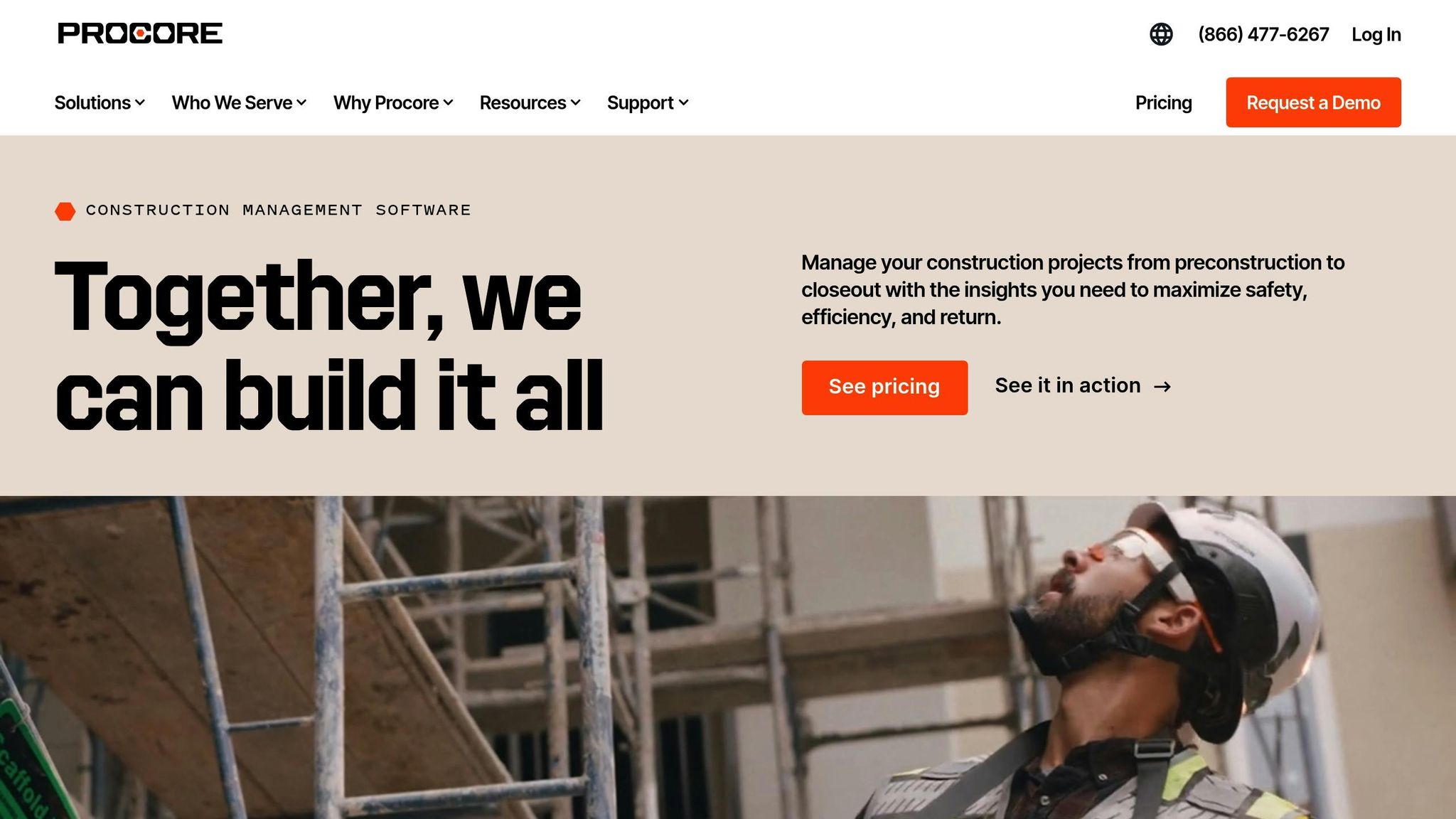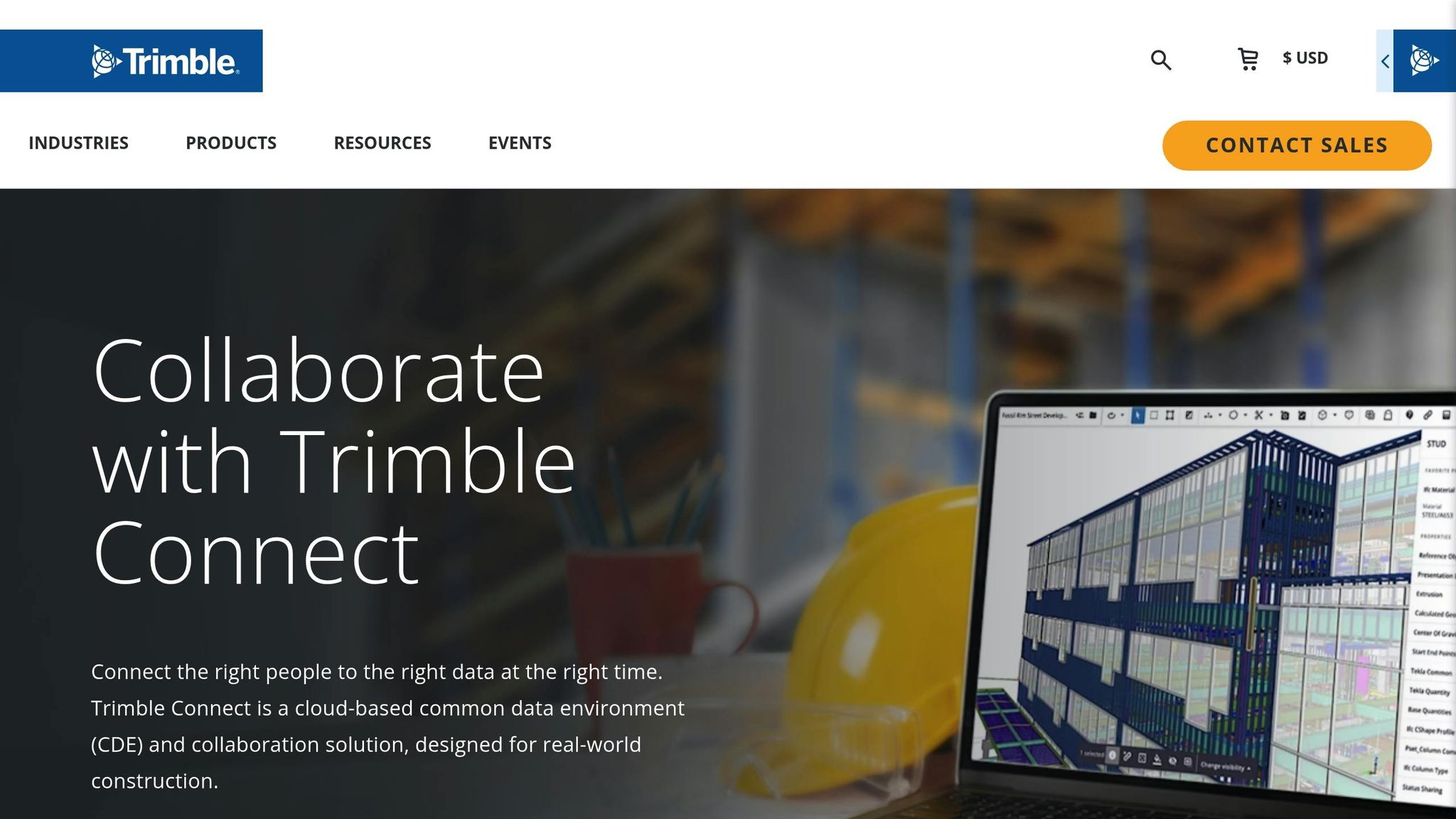Enterprise Visualization Platforms for Large-Scale Construction: The Definitive Comparison
Taher Pardawala May 20, 2025
Choosing the right visualization platform can make or break a construction project. With modern tools like Autodesk BIM 360, Procore, and Trimble Connect, teams can reduce errors, improve collaboration, and save valuable time. Here’s what you need to know:
- Autodesk BIM 360: Best for advanced BIM workflows, clash detection, and robust integrations. Ideal for large, complex projects.
- Procore: Excels in real-time collaboration, safety management, and resource planning. Great for mid-to-large commercial projects.
- Trimble Connect: Affordable and user-friendly, with strong data-sharing and model management tools. Perfect for budget-conscious teams.
Quick Comparison
| Platform | Strengths | Limitations | Cost |
|---|---|---|---|
| Autodesk BIM 360 | Advanced clash detection, strong integrations | Steep learning curve, high cost | $945–$1,284/user annually |
| Procore | Real-time collaboration, safety features | Overly complex for smaller projects | Custom pricing |
| Trimble Connect | Affordable, easy to use | Fewer integrations, limited BIM features | $12.99–$23.95/user monthly |
The right choice depends on your project size, complexity, and budget. Read on for a deeper dive into each platform’s features and real-world applications.
Procore vs Autodesk BIM 360 – Which One is Better ?

1. Autodesk BIM 360
Autodesk BIM 360, now part of the Autodesk Construction Cloud (ACC), is designed to simplify and optimize large-scale construction projects.
Core Capabilities
BIM 360 offers robust features that help improve project efficiency:
- Collaboration and coordination: Scored 92.6% effectiveness [3]
- Documentation and reporting: Rated at 86.36% [3]
- Model validation and quality control: Achieved 86.67% [3]
- Integration and interoperability: Rated at 80% [3]
AECOM, for instance, reduced rework to less than 1% on their projects by using BIM coordination and multi-discipline collaboration – well below the industry average of 8–10% [5].
Advanced Collaboration Features
The platform’s cloud-based environment makes team coordination smoother and faster. Designer Group, for example, cut model syncing time by 83% with BIM Collaborate Pro [6].
"With Build, we can make informed decisions, and there’s no longer a divide between knowledge across our teams. Project managers are empowered to produce reports; they don’t have to wait for accounting. This streamlines our process and allows project managers to make real-time project decisions."
Integration and Scalability
BIM 360 integrates seamlessly with over 400 business tools, including ERP, CRM, document management, and analytics systems [4].
For projects with varying complexity, BIM 360 offers tiered service options:
| Feature | BIM Collaborate Pro | BIM Collaborate |
|---|---|---|
| Annual Cost | $1,284/user | $945/user |
| Model Reviews | Comprehensive | Basic |
| Worksharing | Full support for Revit, Civil 3D, Plant 3D | Not supported |
| Clash Detection | Advanced | Basic |
| Document Management | Centralized in Autodesk Docs | Centralized in Autodesk Docs |
Note: These tiered options allow teams to choose the right fit for their project needs.
Real-World Impact
BIM 360 has delivered measurable improvements for its users:
- CPPI saw a 3X boost in productivity and accuracy by streamlining cost workflows [4].
- Oktra’s design team saved 30 minutes per day, on average, using ACC’s collaborative tools [4].
- The Port of Antwerp-Bruges overcame challenges with outdated information by building a comprehensive digital twin using BIM 360 [4].
These examples demonstrate how Autodesk BIM 360 supports efficient, modern construction workflows, paving the way for a comparison with other industry platforms.
2. Procore
Procore is a cloud-based platform designed to streamline construction management by focusing on real-time collaboration and visualization.
Core Functionality
Procore centralizes construction management tasks effectively, with 88% of reviews highlighting its success in this area [7]. The platform’s BIM-powered visualization tools allow teams to:
- Review 3D construction plans
- Conduct clash detection
- Improve the accuracy of project planning
- Perform digital takeoffs for precise material estimation
These features help teams work more efficiently and collaboratively.
Real-Time Collaboration & Data Integration
Procore combines its core features with real-time collaboration and robust data integration. This unified approach has led to measurable improvements in construction processes:
| Metric | Improvement |
|---|---|
| RFI & Submittal Processing | 8 days faster on average [12] |
| Overall Project Timeline | 15-day average reduction [12] |
| Field-to-Office Communication | 90% improvement [12] |
| Safety Incident Reduction | Over 20% decrease [10] |
| Team Productivity | Up to 12% increase [10] |
Resource Management Capabilities
Procore’s resource planning tools ensure efficient workforce deployment. Sheri Johnson, Senior Vice President at McCownGordon, shares:
"Procore helps us manage our workforce in the field and make sure the right people are in the right place at the right time" [14].
Scalability Success
Scalability is a key strength for Procore, especially in large-scale projects. For example, Spartan Investment Group used the platform to grow its annual revenue from $2.5 million to $10 million by increasing team productivity and redistributing tasks [13].
Bradley Watts, Project Manager at SHAPE, highlights Procore’s versatility:
"Today we use Procore for tendering, building our project directory and running our meetings, correspondence and safety observations through a centralised platform. We’ve automated key items throughout a project lifecycle and lean on AI to check documents against each other so we can minimise the risk component of any project" [15].
Integration Ecosystem
Procore supports a wide range of integrations, including financial management systems, design tools, scheduling applications, ERP systems, and HRIS platforms. These integrations help maintain consistent data and reduce redundant entries. The introduction of Procore AI in November 2024 further enhanced its automation capabilities [9].
Performance Metrics
User satisfaction with Procore remains strong, as recent data shows:
| Aspect | Positive Rating |
|---|---|
| Project Management | 91% [7] |
| Field Operations | 89% [7] |
| Mobile Accessibility | 89% [7] |
| Construction Management | 88% [7] |
| Cost-to-Value Satisfaction | 84% [8] |
Ron Johnson, CEO of Peninsulators, underscores Procore’s comprehensive approach:
"Operations is all about people, technology, and process coming together – and we leverage the heck out of Procore Resource Planning in all of that" [11].
sbb-itb-51b9a02
3. Trimble Connect

Trimble Connect is a cloud-based platform designed to simplify construction management and visualization for large-scale projects. With a user base exceeding 30 million worldwide [16], it has become a go-to solution for improving efficiency across the construction industry.
Core Features and Performance
This platform provides a suite of tools tailored to optimize construction workflows through advanced visualization capabilities:
| Feature Category | Capabilities |
|---|---|
| File Support | Handles 2D, 3D, Point Cloud, and Geospatial formats |
| Model Management | Offers version control, change tracking, and coordination tools |
| Collaboration | Enables real-time sharing, reviewing, and commenting |
| Mobile Access | Allows viewing of 3D models on tablets and smartphones |
| Security | Includes role-based access, data encryption, and compliance with ISO/IEC 27001:2013 standards |
Boosting Efficiency
Trimble Connect delivers measurable improvements in construction efficiency:
- Cuts labor metrics by 50% [16].
- Speeds up the RFI process from two weeks to just three days [16].
- Centralizes data management, streamlining decision-making [19].
These advancements make it a powerful tool for tackling complex projects.
Real-World Implementation
The Bergünerstein Tunnel project in Switzerland showcases how Trimble Connect can transform infrastructure management. In this project, Donatsch + Partner AG, Rhomberg Bahntechnik AG, and Amberg Engineering AG collaborated seamlessly using the platform. Fadri Jecklin, Project Manager at Donatsch, highlighted its impact:
"Using the cloud and Trimble Connect is standard practice on all our larger projects now. It streamlines communication significantly compared to traditional email and file-sharing methods." [18]
Integration Ecosystem
Trimble Connect is available across multiple platforms, including Windows, web browsers, and mobile devices. Markku Räisänen, Head Designer at Betset, shared his perspective:
"Trimble Connect is evolving to be a true collaboration platform enabling us to easily share, review, coordinate and comment on data-rich building models in real-time." [16]
Flexible Plans for Different Needs
The platform offers tiered pricing plans to accommodate projects of varying sizes and complexities:
| Plan Type | Cost | Features |
|---|---|---|
| Personal | Free | 1 project, 5 members, 10 GB storage |
| Business Monthly | $12.99/user/month | Unlimited projects and data |
| Business Annual | $9.99/user/month | Unlimited projects and data |
| Premium | $23.95/user/month | Advanced BIM tools and enriched 3D workflows |
Advanced Capabilities
Trimble Connect also includes advanced tools to enhance productivity. These features encompass automated workflows for repetitive tasks, issue tracking with clear priorities, and centralized coordination for architectural, structural, and MEP models [17]. Andrew Stewart, Systems Manager at Central Steel Build, emphasized the platform’s value:
"One of the main benefits is accessibility, for internal and external stakeholders, to all the documents related to a specific job through a single repository." [16]
Platform Strengths and Limitations
Let’s take a closer look at the strengths and challenges of some of the leading visualization platforms used in large-scale construction projects.
Comparative Analysis
| Platform | Key Strengths | Limitations |
|---|---|---|
| Autodesk BIM 360 | • Strong project delivery and management tools [2] • Real-time collaboration on Revit models • Advanced clash detection features • Smooth integration with other Autodesk products |
• Complicated project setup process [21] • Difficulty in tracking user access [23] • Limited use outside BIM workflows [24] • Steep learning curve for new users |
| Procore | • Connects with over 200 tools [24] • Extensive financial management features • Strong focus on safety compliance • Mobile-friendly for on-the-go access |
• Lacks detailed permission settings [22] • Limited sorting options in Prime Contracts [22] • Overly complex for smaller projects [24] • Constraints with one-to-one ERP relationships [22] |
| Trimble Connect | • Cuts labor metrics by 50% [16] • Speeds up RFI processes from 2 weeks to 3 days [16] • Easy-to-use interface • Affordable pricing options |
• Fewer third-party integrations [24] • Limited BIM functionalities [24] • May require hardware upgrades [17] |
These strengths and limitations are seen in practice, shaping how teams use these platforms in real-world scenarios.
Performance Insights
When used in real-world projects, these platforms deliver varying levels of success. René de Groot, Director at DigiBase, highlights the importance of centralized data management:
"We quickly saw that a common data environment for all projects would help VolkerWessels transform the way we collaborate." [16]
Such insights underline the importance of considering not just features, but also how well a platform integrates into your team’s workflow.
Cost Considerations
Pricing structures differ across platforms, and understanding these costs is essential:
- Procore: Custom pricing tailored to project volume [20]
- BIM 360: Annual subscription fees based on user count [17]
- Trimble Connect: Starts at $12.99/user/month for Business Monthly plans [16]
While cost is a key factor, it’s equally important to evaluate how a platform’s connectivity and features align with your project’s needs.
Integration Capabilities
Integration options vary significantly. For example, Autodesk Construction Cloud combines workflows with predictive analytics and machine learning [2], making it a powerful choice for data-driven teams.
User Experience Feedback
User experiences provide valuable insight into platform performance. Matt Bennett, Vice President at Bennett Steel, shared:
"Right away, Trimble Connect accelerated our workflows and made collaboration between the shop and the field seamless." [16]
Ultimately, the best platform depends on your specific project requirements, team size, and how well it integrates with your existing tools. Carefully assess these factors to ensure the platform you choose supports your goals effectively.
Summary and Recommendations
Based on the detailed analysis above, selecting the right platform for your project depends on its scale and specific needs. Below, we break down recommendations by project size, industry outcomes, and key investment considerations.
Recommendations Based on Project Size
- Large-Scale Infrastructure Projects: Autodesk BIM 360 stands out for its construction management (78% support) and collaboration (93% support) features. For instance, Jacobs Engineering Group reported a 30% improvement in project coordination using this platform [3][26].
- Mid-Sized to Large Commercial Projects: Procore proves highly effective for managing complex workflows and team coordination, making it a strong choice for these types of projects.
These examples highlight how platform strengths align with different project demands, offering a clear framework for decision-making.
Industry-Specific Success Stories
Leading companies have shared measurable benefits from adopting these platforms, including productivity gains, time savings, and fewer revision cycles. Here are a few notable examples:
| Company | Platform | Results |
|---|---|---|
| CPPI | Autodesk Build | Achieved 3X gains in productivity and accuracy [4] |
| Oktra | Autodesk Construction Cloud | Saved 30 minutes per designer, per day [4] |
| HOK | BIM 360 | Reduced revision and approval time by 40% [26] |
These outcomes underline the tangible impact of choosing the right technology.
Key Considerations for Technology Investments
When evaluating platforms, keep these factors in mind:
- Integration and Ease of Use
Look for tools that integrate seamlessly with your current systems and offer an intuitive interface for faster adoption.
"Build allows us to make informed decisions and streamlines processes" [4]
- Cost-Benefit Analysis
While the initial investment might seem high, the long-term returns – such as improved productivity and efficiency – are often substantial.
Choosing the right platform is just the first step; its implementation plays a critical role in achieving these benefits.
Best Practices for Implementation
To ensure success after selecting a platform:
- Choose tools that address at least 80% of your critical processes and provide comprehensive training for your team [25].
- Establish strong data management practices to enable better visualization and decision-making [1].
- Regularly evaluate and refine how the platform is being used to adapt to evolving project needs [1].
Balancing technical capabilities with team adoption strategies is key to unlocking improvements in efficiency and collaboration. By following these practices, organizations can maximize the value of their technology investments.
FAQs
How can I choose the best visualization platform for my large-scale construction project?
When choosing a visualization platform for your construction project, there are a few important aspects to keep in mind. First, assess the platform’s 3D modeling features and real-time collaboration tools. These are crucial for handling complex workflows and ensuring smooth communication across your team.
Also, consider whether the platform allows for data integration with your current project management tools. This can help streamline operations and minimize inefficiencies. An intuitive, user-friendly interface is another key factor – it can cut down on training time and make it easier for your team to get up to speed.
Lastly, explore case studies or testimonials from other professionals in the construction field. These examples can offer valuable insight into how the platform performs in practical, on-site situations, helping you choose a solution that aligns with your project’s specific demands.
How do the pricing and key features of Autodesk BIM 360, Procore, and Trimble Connect compare for large-scale construction projects?
Autodesk BIM 360 operates on a subscription-based pricing structure, starting at $1,284 per user annually. While it offers a wide range of features, teams looking for advanced tools should anticipate additional costs. This platform is well-suited for those who need extensive functionality.
Procore, on the other hand, uses a fixed annual contract model that supports unlimited users. Pricing starts at roughly $500 per month for teams with more than ten users. Its predictable costs and scalability make it appealing for larger teams.
Trimble Connect provides a more budget-friendly option, with plans starting at $10 per user per month. While it’s an economical choice for smaller teams, it may not include some of the advanced features available in the other platforms.
To sum up, Autodesk BIM 360 offers extensive capabilities at a premium price, Procore balances scalability with consistent costs, and Trimble Connect is a cost-effective solution for smaller teams with simpler requirements.
How do enterprise visualization platforms boost teamwork and streamline large-scale construction projects?
Enterprise visualization platforms play a crucial role in boosting teamwork and streamlining operations in large-scale construction projects. With real-time collaboration features, team members can simultaneously access and update 3D models, keeping everyone on the same page regarding project goals, changes, and progress. This minimizes miscommunication and ensures faster, more informed decision-making.
These platforms also centralize project data, providing a unified view of schedules, resource allocation, and budgets. This level of clarity allows teams to spot and address potential issues early, helping to keep projects on track and within budget. By blending cutting-edge visualization tools with efficient collaboration, these platforms make managing the complexities of construction projects much more straightforward.
Related posts
- Cloud Rendering Showdown: Foyr vs. Coohom for Professional 3D Visualization
- How Small AEC Firms Can Leverage Cloud Technology to Win Enterprise Projects
- VR/AR Applications Transforming Client Presentations for Construction Projects
- AI Feature Comparison: How Leading AEC Visualization Tools Stack Up in 2025








Leave a Reply